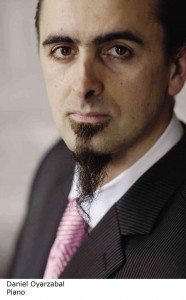
The upcoming performance of Spanish artist Enrique Viana at the Cultural Center of the Philippines in June should be a rare opportunity to revel in the beauty of zarzuela music.
Viana, one of the leading men in Spanish zarzuela, and Spanish pianist Daniel Oyarzabal will headline the performance billed as Romantico Enrique Viana (“The Unending Passion of the Zarzuela”) on June 11, 8 p.m., at the CCP Little Theater.
The event is presented in collaboration with the CCP, Embassy of Spain, and Instituto Cervantes de Manila.
The show is described as “a recital leading audiences through the zarzuela and Spanish culture in the 19th and 20th century’s theaters. Through illustrative productions, anecdotes and brief remarks on the lyrical genre, Viana and Oyarzabal will unveil to the world of Spanish zarzuela.”
The zarzuela is a Spanish theater art form. It is a lyric-dramatic genre that alternates between spoken and sung scenes, the latter incorporating operatic and popular song as well as dance.
Magic formula
The etymology of the name is not totally certain, but some propose it may derive from the name of a Royal hunting lodge, the Palacio de la Zarzuela near Madrid, where, allegedly, this type of entertainment was first presented to the court. The palace was named after the place called La Zarzuela because of the profusion of brambles (zarzas) that grew there, and so the festivities held within the walls became known as Zarzuelas.
Viana says: “The zarzuela tried and successfully managed, through music and situations, the feelings, realities and stories of characters in a sincere, open and effective manner. The cadences, rhythms and melodies of our land went directly to the heart of the hearer. I think the authors of the late 19th century until the middle of the last century found a magic formula for writing the smells of basil; night lights and dawns, Basque or Galician; the cool rain after a festival in Madrid; or silence; the Andalusian summer heat …”
Nicanor G. Tiongson in his article in the CCP Encyclopedia of Philippine Art, says the Spanish zarzuela was introduced to Manila in 1879 or 1880 with a performance of “Jugar con Fuego” by the troupe of Dario de Cespedes. More groups followed, playing in Manila, Iloilo, Cebu, Pampanga and Bicol. As it grew in popularity, the zarzuela was appropriated by Filipino composers who turned it into the sarswela with songs written in various Philippine dialects.
The heyday of the Filipino sarwuela was between 1900 and 1940, after which the bodabil and movies of the pre-World War II era signaled the start of its decline.
‘Zarzuela’ lives on
In modern-day Philippines, says Tiongson, who is a scholar and expert on Philippine art and culture, the traditional staged zarzuela may be found only in Ilocos, while revitalized sarswela are sometimes done in Manila and in Silay City, Negros Occidental.
The Filipino sarswela, he says, is a play in prose with songs and dances, containing from one to five acts, portraying Filipino types and situations within the framework of a love story, and incorporating contemporary issues.
In 1979, on a visit to Spain, Tiongson found the zarzuela to be alive and kicking. There was a revival, he recalls. “There were performances as well as recordings of classic zarzuelas. One output of this revival was the show called “Antologia de la Zarzuela” which was toured all over the world. It showcased the most famous scenes and arias from the most famous Spanish zarzuelas, such as ‘Jugar Con Fuega.’”
Tiongson compares Spanish and Filipino zarzuelas.
“They are both written in prose and feature songs that express emotion in particular scenes. In everything else, they differ,” says Tiongson.
“In terms of musical forms, the sarswela used popular native forms such as the kundiman, balitaw and danza, and even American forms like the fox trot. In terms of themes and plots, the sarswela dwelt on contemporary concerns like abuses by the religious, corruption in government, Americanization of the Filipino, usury, and gambling.
“In terms of characters, the sarswela portrayed common social types encountered on the streets, and, in terms of dialogue, used colloquial language that captured the pulse of everyday life.”
Common people
But whatever the differences, Tiongson says, “I think the form’s defining quality was the fact that it expressed the soul of the common people, both in Spain and the Philippines. In Spain, it was lionized by the common folk because it was truly the “hija del pueblo,” as opposed to the high-flown Italian opera which was patronized by the Spanish aristocracy. In the Philippines, it became popular because it was the “mirror of everyday life,” unlike the komedya which was about faraway kings and queens, or the Italian opera which was patronized by the elite.”
Conceptualized as a “sing-and-tell” show about the zarzuela, Viana says the show will feature brief introductions and small illustrative comments on the Spanish lyrical genre.
“The songs are easy to listen to and recognize; has color, grace and panache,” says Viana. “They also invite to sing, to laugh, to dance, to look and live on the pulse of our streets, towns, parks, plains and mountains.”
Viana specializes in the bel canto repertoire, and in some French Romantic authors. On the operatic stage, he has played major roles such as the Duke in “Rigoletto”; Alfredo in “La Traviata”; Fenton in “Falstaff”; D. Basilio in “The Marriage of Figaro”; Ernesto in “Don Pasqual”; and Tonio in “La fille du regiment”; Count Almaviva in “The Barber of Seville.”
As soloist with leading roles in oratorios, concerts and operas, he has performed in festivals and theaters in the US, France, England, Germany, Italy, Belgium, Portugal, Canada, China, Korea, Philippines, Argentina, Cuba, Costa Rica, Peru, Venezuela, Bulgaria, Egypt, Mexico, Chile, Uruguay and Hungary.
He has given courses and lectures on singing in 20 universities in Spain and Latin America.
Call CCP Box Office at 832-3704; visit www.culturalcenter.gov.ph.